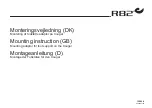
T
(450) 588-6555 - 1 866 650-6555
F
(450) 588-0200
24
If you ignore these Warnings or fail to inspect or maintain your
wheelchair as directed in the manual , you may fall, tip over or lose
control of the wheelchair and seriously injure yourself or others or
damage the wheelchair.
14.
DECLARATION OF
CONFORMITY
Name and Address of Product Owner
Motion Composites Inc.
160, Armand-Majeau Sud
Saint-Roch-de-l’Achigan, Quebec
J0K 3H0 Canada
Phone: 1-866-650-6555
Fax: (450) 588-0200
www.motioncomposites.com
Authorized representative
Advena Ltd.
Pure Offices, Plato Close, Tachbrook Park, Warwick
CV34 6WE, United Kingdom
We hereby declare that the below mentioned devices
have been classified according to the classification
rules and conform to the Essential Principles of Safety
and Performance as laid out in the Health Products
(Medical Devices) Regulations 93/42/CEE.
Medical Device(s):
APEX manual wheelchair
Manufacturing site:
Motion Composites Inc.
160, Armand-Majeau Sud
Saint-Roch-de-l’Achigan, Quebec
J0K 3H0 Canada
Risk classification:
Class 1 Medical Device (per 93/42/CEE).
Standards applied:
• NF EN ISO 7176-1:
Wheelchairs, part 1: Determination of static ability.
• NF EN ISO 7176-5:
Wheelchairs, part 5: Determination of dimensions,
mass and maneuvring space.
• NF EN ISO 7176-8:
Wheelchairs, part 8: Requirements and test methods
for static, impact and fatigue strengths.
• NF EN ISO 7176-11:
Wheelchairs, part 11: Test Dummies.
• NF EN ISO 7176-15:
Wheelchairs, part 15: Requirements for information
disclosure, documentation and labeling.
This declaration of conformity is valid from 2013/10/28.
I. Appendix
I.I
TABLE “FRONT SEAT-TO-FLOOR HEIGHTS”
Front Frame Angle Height available
± ¼”
(0.6 cm)
70°
14” (35.6 cm) to 21” (53.34 cm)
75°
14” (35.6 cm) to 21” (53.34 cm)
80°
14” (35.6 cm) to 21” (53.34 cm)
85°
14” (35.6 cm) to 21” (53.34 cm)
90°
14” (35.6 cm) to 21” (53.34 cm)
I.II
TABLE “REAR SEAT-TO-FLOOR HEIGHTS”
Wheel size
Height available
± ¼”
(0.6 cm)
20” wheel
14” (35.6 cm) to 17 ½” (44.5 cm)
22” wheel
14” (35.6 cm) to 18 ½” (45.7 cm)
24” wheel
15” (31.8 cm) to 19 ½” (47.0 cm)
25” wheel
15 ½” (39.4 cm) to 20” (50.8 cm)
26” wheel
16” (40.6 cm) to 20” (50.8 cm)
Conversion
chart
Inches Metric
Inches Metric
Inches Metric
Inches Metric
1/4”
0.6 cm
1”
2.5 cm
10”
25.4 cm
19”
48.3 cm
1/2”
1.3 cm
2”
5.1 cm
11”
27.9 cm
20”
50.8 cm
3/4”
2.0 cm
3”
7.6 cm
12”
30.5 cm
21”
53.3 cm
4”
10.2 cm
13”
33.0 cm
22”
55.9 cm
5”
12.7 cm
14”
35.6 cm
23”
58.4 cm
6”
15.2 cm
15”
38.1 cm
24”
61.0 cm
7”
17.8 cm
16”
40.6 cm
25”
63.5 cm
8”
20.3 cm
17”
43.2 cm
26”
66.0 cm
9”
22.9 cm
18”
45.7 cm

































